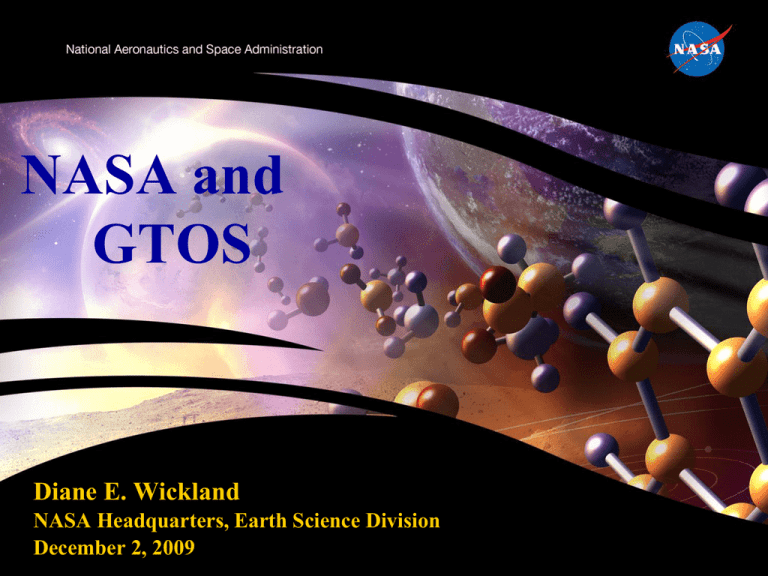NASA and GTOS Diane E. Wickland NASA Headquarters, Earth Science Division
advertisement

NASA and GTOS Diane E. Wickland NASA Headquarters, Earth Science Division December 2, 2009 U.S. Global Change Research Program (USGCRP) Major Recommendations for the USGCRP* 1. Reorganize the program around integrated scientific-societal issues to facilitate crosscutting research focused on understanding the interactions among the climate, human, and environmental systems and on supporting societal responses to climate change. 2. Establish a U.S. climate observing system, defined as including physical, biological, and social observations, to ensure that data needed to address climate change are collected or continued. 3. Develop the science base and infrastructure to support a new generation of coupled Earth system models to improve attribution and prediction of high-impact regional weather and climate, to initialize seasonal-to-decadal climate forecasting, and to provide predictions of impacts affecting adaptive capacities and vulnerabilities of environmental and human systems. 4. Strengthen research on adaptation, mitigation, and vulnerability. 5. Initiate a national assessment process with broad stakeholder participation to determine the risks and costs of climate change impacts on the United States and to evaluate options for responding. 6. Coordinate federal efforts to provide climate services (scientific information, tools, and forecasts) routinely to decision makers. * From the National Research Council’s 2009 report, Restructuring Federal Climate Research to Meet the Challenges of Climate Change. 3 NASA Earth System Science 50 Years of Earth Observations from Space The U.S. National Research Council (NRC) reviewed U.S. accomplishments in Earth remote sensing from space and concluded (summarized): • The daily synoptic view of Earth from space has revolutionized Earth studies and helped society manage environment and resources • Long time series are required and the value of data sets increases with time • Scientific advances result from science-technology synergy, and societal benefit of measurements increases with increasing accuracy • Have indisputable benefit of multiple synergistic observations (satellite and non-satellite) linked with models • To achieve full benefit of observations, need infrastructure (models, computing, ground networks, personnel) • Full and open access to global data capitalizes on investment • Space observations have catalyzed interdisciplinary science and can be expected to lead to remarkable discoveries in the future 5 End-to-end Observations for a Globally Integrated Program Airborne Sensors Uninhabited Aerial Vehicles Research Balloons Field Campaigns Buoys Ground Networks Research Vessels Ground Stations Ground Stations Research Balloons Ground, sea, air and in-situ measurements augment space-based observations to help understand Earth system functioning and global environmental change 6 6 20 Years of Earth System Science • We have learned many things about the Earth system and our understanding: • • • We have documented and quantified variability, trends, and change in the Earth system High-quality observations reveal new phenomena and processes We have learned in some cases that our understanding was inadequate – or wrong • We have developed advanced capabilities to: • • • • • There are new phenomena and problems to be addressed, for example: • • • • Handle and process large volumes of data Create multi-sensor, multi-satellite data products and time series data products Conduct inter- and multi-disciplinary science Improve component models and advance toward Earth System models The ice is melting faster than predicted The ocean is becoming more acid, with potential large impacts on ecosystems There are concerns about increases in the frequency and intensity of extreme events -especially with respect to their impacts in built-up areas with large human populations Our successes in documenting change are leading to new demands for scientific assistance in the development and implementation of policies to address climate change • • Decision support is becoming an increasing important element within the USGCRP Observations are needed for monitoring and assessing efficacy of mitigation 7 actions (with significant implications for accuracy, reliability, etc.) NASA’s Missions for New and Continuing Observations The U.S. NRC’s Decadal Survey for ~2010-2020 • In 2007, the Space Studies Board of the National Research Council (NRC) of the U.S. National Academies of Science, Engineering, and Medicine released a community assessment and strategy for the future entitled: Earth Science and Applications from Space: National Imperatives for the Next Decade and Beyond (aka the “Decadal Survey”) • The Decadal Survey, in combination with the NRC’s reports on the USGCRP and other related activities, provides guidance for NASA’s future Earth Science program 9 NASA’S Current Operating Research Missions 10 NASA’s Missions in Formulation and Implementation OCO Feb 23, 2009 ICESat-II 2014 (TBR) GLORY 1/2010 (TBR) GPM 7/2013, 11/2014 AQUARIUS 5/2010 SMAP 2013 NPP 12/2010 (TBR) LDCM 12/2012 11 12 Land Surface Imaging Constellation 1414 LSI Constellation Study Team - 2009 CEOS Agency Members • USGS: • • • • • • • • • • • • • • • ISRO: INPE: INPE: EC: ESA: CSA: CONAE: JAXA: NOAA: NASA: NRSCC: CRESDA: GISTDA: CNES: CDTI: Co-Chair, Tom Holm (new 2009) (G. Bryan Bailey retired) Co-Chair, V. Hegde (new 2009) Co-Chair, (To be named) João Vianei Soares Herve JeanJean Michael Berger Daniel DeLisle Ana Medico Takeo Tadono Kevin Gallo Garik Gutman Yonghong Zhang Xiaohua Yi Phuriwaj Ruengnaowaroj Aurelie Sand Mónica Lopez CEOS WG Members • WGCV (NASA): • WGCV (USGS): Stephen Ungar Greg Stensaas User Community Members • • • • • • • USGS: JRC: JPL: Nagoya U.: BGS: U. Maryland: CSIRO: Brad Reed Alan Belward Mike Abrams Yasushi Yamaguchi Stuart Marsh J. Townshend Alex Held 15 Status of Activities and Future Plans LSI Portal: Potential enhancements in cooperation with CEOS Working Group on Information Systems and Services (WGISS). Options under consideration: Complete development of web-based services and/or freeware (INPE) Image format converter tool to GeoTIFF Ortho-rectification tool for Level 1 mid-resolution data Working Group on Radar (WGR) – not yet a formal sub-group of LSI, although terms of reference established. LSI Mid-Resolution Optical Guidelines Document Working Group on Regional Data Set Compilation (WGRDSC) Addition of new data types or descriptive information Expand functionality to include cross-system, granule-level, search and data retrieval Currently working to assemble initial data sets for GLS 2010 LSI Constellation is currently evaluating combining data requirements with the GEO Forest Carbon Tracking task 16 Forest Carbon Tracking – LSI Support Satellite Spectral Bands Geometric Resolution Swath Width Repeat Cycle Landsat 5, 7 VNIR, SWIR, TIR 30 m / 120 m (TIR) 185 km 16 days IRS: AWiFS VNIR, SWIR 56 m 740 km 4 days IRS: LISS-III VNIR, SWIR 23 m 140 km 24 days CBERS 2b: CCD, VNIR 20 m 114 km 26 days AVNIR-2 VNIR 10 m 70 km 46 days SPOT 4, 5 VNIR, SWIR 20 m / 10 m 60 km 26 days Kompsat-2 VNIR 1m/4m 15 km 28 days Summary requirement for all optical satellites: Acquisition preferably close to nadir for all National Demonstrators Cloud free observations (< 20 % cloud coverage for individual scenes – total cloud removal by multiple scenes) All available spectral bands Time window – yearly during dry season (long term vision) 17 Thank You!
